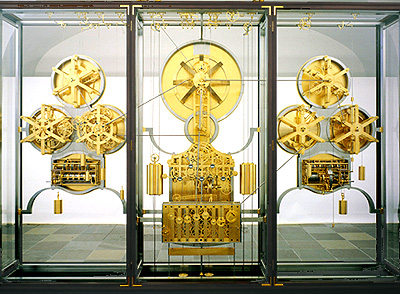Jens Olsenís Astronomical Clock |
| The Restoration
The expertise of atelier ANDERSEN formed the basis needed to undertake the major task of getting Jens Olsen's astronomical Clock back to perfect working order. A staff of specialists has carried out the assignment at atelier ANDERSEN's workshop. At the same time, experts in astronomy, construction, and metallurgy were involved in the project. Due to lesser friction the technical solutions used secure the mechanical parts of the clock much more wear-resistance in the future. The astronomical Clock is now in optimal condition - according to the intentions of Jens Olsen. Facts about the Astronomical Clock |
| The influence of sunlight
In 1991 it was ascertained that many of the readings on Denmark's famous astronomical clock did not match the almanac. Restorer/horologist Søren Andersen and astronomer The planet movement had stuck and, furthermore, several of the clock dials had become hard to read because of a thick coat of lacquer and of the blackening of the engravings of the scales. Many of the works were affected by corrosion on steel- and brass parts. |
|
In August 1995 Atelier ANDERSEN began the task of dismanteling the clock. The 11 works were dismantled in sections, taken apart and cleaned. Each part was numbered. Every bronze or brass part was gilt to recreate the original finish, with 5 micron fine gold coat giving a yellow brass-like colour. Some shafts were coated with a special mixture of nickel and teflon, which reduces friction. Small, invisible ball-bearings were mounted on almost every rotating axle.  The finely engraved dials were originally silvered with the engraving in black-brown patina of silver sulphide - a non-durable solution which in a few years led to blackened dials. Gunnar Biilmann Petersen wanted rhodium coated dials, and therefore this durable surface was chosen. It results in a slightly more steel-like lustre, but the incredibly delicately engraved dials are now proof against blackening. The restoration was completed in January 1997. |